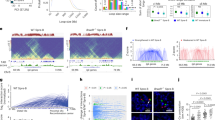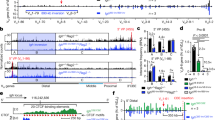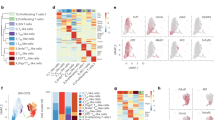Abstract
Thymic development produces two sub-lineages of T cells expressing either CD4 or CD8 co-receptors that assist antibody production and mediate cell killing, respectively. The mechanisms for mutually exclusive co-receptor expression remain poorly defined1,2. We find that mutations in the high mobility group (HMG) domain of BAF57—a DNA-binding subunit of the mammalian SWI/SNF-like chromatin-remodelling BAF complexes—or in the BAF complex ATPase subunit Brg, impair both CD4 silencing and CD8 activation. Brg is haploinsufficient for CD8 activation, but not for CD4 silencing, whereas BAF57 mutations preferentially impair CD4 silencing, pointing to target- and subunit-specific mechanisms of chromatin remodelling. BAF complexes directly bind the CD4 silencer, but the BAF57 HMG domain is dispensable for tethering BAF complexes to the CD4 silencer or other chromatin loci in vivo, or for remodelling reconstituted templates in vitro3,4, suggesting that chromatin remodelling in vivo requires HMG-dependent DNA bending. These results indicate that BAF complexes contribute to lineage bifurcation by reciprocally regulating lineage-specific genes, reminiscent of the role of the yeast SWI/SNF complex in mediating mating-type switching5,6.
This is a preview of subscription content, access via your institution
Access options
Subscribe to this journal
Receive 51 print issues and online access
$199.00 per year
only $3.90 per issue
Buy this article
- Purchase on Springer Link
- Instant access to full article PDF
Prices may be subject to local taxes which are calculated during checkout




Similar content being viewed by others
References
Ellmeier, W., Sawada, S. & Littman, D. R. The regulation of CD4 and CD8 coreceptor gene expression during T cell development. Annu. Rev. Immunol. 17, 523–554 (1999)
Sarafova, S. D. & Siu, G. Control of CD4 gene expression: connecting signals to outcomes in T cell development. Braz. J. Med. Biol. Res. 32, 785–803 (1999)
Wang, W. et al. Architectural DNA binding by a high-mobility-group/kinesin-like subunit in mammalian SWI/SNF-related complexes. Proc. Natl Acad. Sci. USA 95, 492–498 (1998)
Phelan, M. L., Sif, S., Narlikar, G. J. & Kingston, R. E. Reconstitution of a core chromatin remodeling complex from SWI/SNF subunits. Mol. Cell 3, 247–253 (1999)
Stern, M., Jensen, R. & Herskowitz, I. Five SWI genes are required for expression of the HO gene in yeast. J. Mol. Biol 178, 853–868 (1984)
Sudarsanam, P. & Winston, F. The Swi/Snf family nucleosome-remodeling complexes and transcriptional control. Trends Genet. 16, 345–351 (2000)
Bultman, S. et al. A Brg1 null mutation in the mouse reveals functional differences among mammalian SWI/SNF complexes. Mol. Cell 6, 1287–1295 (2000)
Klochendler-Yeivin, A. et al. The murine SNF5/INI1 chromatin remodeling factor is essential for embryonic development and tumour suppression. EMBO Rep. 1, 500–506 (2000)
Roberts, C. W., Galusha, S. A., McMenamin, M. E., Fletcher, C. D. & Orkin, S. H. Haploinsufficiency of Snf5 (integrase interactor 1) predisposes to malignant rhabdoid tumors in mice. Proc. Natl Acad. Sci. USA 97, 13796–13800 (2000)
Reyes, J. C. et al. Altered control of cellular proliferation in the absence of mammalian brahma (SNF2α). EMBO J. 17, 6979–6991 (1998)
Fung-Leung, W. P. et al. CD8 is needed for development of cytotoxic T cells but not helper T cells. Cell 65, 443–449 (1991)
Nakayama, T. et al. Inhibition of T cell receptor expression and function in immature CD4+CD8+ cells by CD4. Science 249, 1558–1561 (1990)
Zou, Y. R. et al. Epigenetic silencing of CD4 in T cells committed to the cytotoxic lineage. Nature Genet. 29, 332–336 (2001)
Leung, R. K. et al. Deletion of the CD4 silencer element supports a stochastic mechanism of thymocyte lineage commitment. Nature Immunol. 2, 1167–1173 (2001)
Teh, H.-S. et al. Participation of CD4 coreceptor molecules in T-cell repertoire selection. Nature 349, 241–243 (1991)
Davis, C. B., Killeen, N., Crooks, M. E., Raulet, D. & Littman, D. R. Evidence for a stochastic mechanism in the differentiation of mature subsets of T lymphocytes. Cell 73, 237–247 (1993)
Agalioti, T. et al. Ordered recruitment of chromatin modifying and general transcription factors to the IFN-β promoter. Cell 103, 667–678 (2000)
Nie, Z. et al. A specificity and targeting subunit of a human SWI/SNF family-related chromatin-remodeling complex. Mol. Cell Biol. 20, 8879–8888 (2000)
Tamkun, J. W. et al. brahma: a regulator of Drosophila homeotic genes structurally related to the yeast transcriptional activator SNF2/SWI2. Cell 68, 561–572 (1992)
Zhao, K. et al. Rapid and phosphoinositol-dependent binding of the SWI/SNF-like BAF complex to chromatin after T lymphocyte receptor signalling. Cell 95, 625–636 (1998)
Godfrey, D. I., Kennedy, J., Suda, T. & Zlotnik, A. A developmental pathway involving four phenotypically and functionally distinct subsets of CD3- CD4- CD8- triple-negative adult mouse thymocytes defined by CD44 and CD25 expression. J. Immunol. 150, 4244–4252 (1993)
Liu, R. et al. Regulation of CSF1 promoter by the SWI/SNF-like BAF complex. Cell 106, 309–318 (2001)
Sawada, S., Scarborough, J. D., Killeen, N. & Littman, D. R. A lineage-specific transcriptional silencer regulates CD4 gene expression during T lymphocyte development. Cell 77, 917–929 (1994)
Acknowledgements
We thank C. Wilson for encouragement and comments; K. Akashi for help with FACS during the early course of the work; K. Stankunas, J. Owen, A. Singer, I. Graef, K. Neu and C. Forsberg for critical readings of the manuscript; T. Magnuson for Brg null mice before publication; R. Perlmutter for Lck promoter constructs; and H. Liu for technical help. T.C. is supported by a fellowship from Leukemia and Lymphoma Society of America. G.R.C. is a HHMI investigator. These studies were funded by a grant from the National Institute of Health.
Author information
Authors and Affiliations
Corresponding author
Ethics declarations
Competing interests
The authors declare that they have no competing financial interests.
Supplementary information
Rights and permissions
About this article
Cite this article
Chi, T., Wan, M., Zhao, K. et al. Reciprocal regulation of CD4/CD8 expression by SWI/SNF-like BAF complexes. Nature 418, 195–199 (2002). https://doi.org/10.1038/nature00876
Received:
Accepted:
Issue Date:
DOI: https://doi.org/10.1038/nature00876
This article is cited by
-
Differential requirements for Smarca5 expression during hematopoietic stem cell commitment
Communications Biology (2024)
-
SWI/SNF complexes in hematological malignancies: biological implications and therapeutic opportunities
Molecular Cancer (2023)
-
cBAF complex components and MYC cooperate early in CD8+ T cell fate
Nature (2022)
-
COMPASS and SWI/SNF complexes in development and disease
Nature Reviews Genetics (2021)
-
GBAF, a small BAF sub-complex with big implications: a systematic review
Epigenetics & Chromatin (2020)
Comments
By submitting a comment you agree to abide by our Terms and Community Guidelines. If you find something abusive or that does not comply with our terms or guidelines please flag it as inappropriate.



